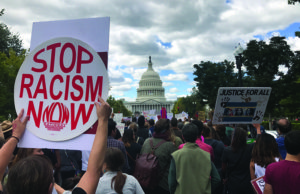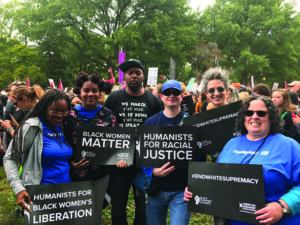Remembering the Elaine Massacre
 Photo by Amy Couch
Photo by Amy Couch On October 1, 1919, a man named Frank Moore gave the following statement (edited here for style and brevity):
On the night of September 30, we were at Hoop Spur Church at a union meeting. Over 120 men, women, and children were there, and outside there were four or five automobiles of white people within about forty or fifty yards from the church. They stopped and started shooting into the church on us and killed some of us. I ran home that night, and the next morning the whites sent us word that they were coming to ‘kill every nigger they found.’ About 11:30 that day there was about 300 or 400 white men, armed with guns, walking and driving automobiles coming from Elaine to kill us. So we all ran and just as we got to the back of a field, we saw a big crowd of white men shooting and killing Jim Miller and his children and brother and setting them on fire. We turned and ran to the railroad east of there, and the white people tried to cut us off. They were shooting at us all the time… I slipped back through the field to save my mother and little children. About five o’clock that evening, there was near 300 more white people coming with guns, shooting and killing men, women, and children. So I took the children and women and went to the woods and hid until the next morning when the soldiers’ train came. I took the children and women to the soldiers; they took us to Elaine village and put us in the white schoolhouse and held us there for five days. Then they took me to Helena County jail and whipped me nearly to death, trying to make me tell stories on the others, to say that we killed the white people and colored people at the church that night. But I did not have a gun… They also put my wife in jail and a great many other women. And they whipped them too. And when they whipped us, they put something in our noses to strangle us and put us in electric chairs and shocked us to make us turn on each other…
The white people want to say that the union was the cause of the trouble. It’s not so; the white people were threatening to take our crops before this trouble started. The Phillips County people know they started this trouble and they only got the army there to cover up what they had done.
Just a few years before hundreds of African Americans were massacred or sentenced to death in Elaine, Arkansas, 350,000 African Americans served as American soldiers in World War I. Several, like those within the segregated, internationally lauded 93rd Infantry Division, fought alongside French soldiers and were awarded the French Legion Award of Honor (171 black soldiers to be exact). They fought boldly for their country, which still refused them the equal benefits of democracy. Their patriotism was ultimately awarded with white aggression and slaughter.
Racial tensions across the country escalated in 1917 as African Americans returning from war and emboldened to fight for their rights exercised their courage by standing up to white oppression. White Americans did not respond well to this newfound boldness; race riots erupted over 350 cities across the United States in 1919. As W. E. B. Du Bois so eloquently wrote, they fought “gladly and to the last drop of blood; for America and her highest ideals.” But, “forced by vindictive fate,” they had also fought “for the dominant southern oligarchy entrenched in Washington…for the America that represents and gloats in lynching, disfranchisement, caste, brutality and devilish insult.” Those who survived returned home determined to live independent, successful lives as fully empowered Americans.
In the early twentieth-century South, whites considered the cotton fields the best place for blacks. They provided cheap labor for white farmers, who promised the black sharecroppers half the cotton crop in exchange for their work. However, as was the case in Elaine, Arkansas, most of the time the farmers didn’t honor their agreement and left the sharecroppers with nothing. “They work ya like a dog until they was through with ya,” said Elmo Scott, a former sharecropper interviewed for a documentary on the riot produced by the Winthrop Rockefeller Foundation. “They would do ya just like you’d do some old dog or hog or something or other.”
On the night of September 30, 1919, roughly 100 black men and women attended a meeting of the Progressive Farmers and the Household Union of America at a church in Hoop Spur (Phillips County), three miles north of Elaine. The gathering was led by Robert Hill, who was the founder of both the farmers group and the union. The sharecroppers had come together to unionize in order to get better payments for their cotton crops. Leaders of the Hoop Spur Union group had placed armed guards around the church to prevent any disruptions by white opponents. Though accounts of who fired the first shots differ from report to report, there was a shootout in front of the church that night between the armed black guards and white men whose vehicles were parked near the church. A white security officer for the Missouri-Pacific Railroad, W. A. Adkins, was killed in the shootout and Phillips County’s white deputy sheriff, Charles Pratt, was wounded.
With a white man’s death, all hell broke loose, and by the following morning the local white sheriff sent out a call to all white Mississippians and Arkansans to come to their aid and “hunt Mr. Nigger in his lair.” White men in cars, trucks, and on foot fired at every black person they saw: men, women, and children. As Arkansas historian Michael Dougan stated, “If it was black and moving, it was target practice.”

Supporters of the AHA’s Black Humanist Alliance marched for racial justice and black women’s liberation on September 30, 2017. (Photo by Amy Couch)
As Frank Moore recounted in his testimony in the groundbreaking case, Moore v. Dempsey, African Americans were surrounded, tortured, and killed. Historical estimates of African-American deaths on that day in Elaine range between 270 and 856. It was the bloodiest twenty-four hours in Arkansas’ history and remains the largest racial massacre in the United States.
The March for Racial Justice was held in conjunction with the March for Black Women in Washington, DC, on September 30, 2017, ninety-eight years after the Elaine Massacre. As stated by the march’s organizers,
These brave black American men and women fought, against all odds, for the protection of their families, communities, and liberty. Their deaths and imprisonment highlight the foundation of white supremacy in our justice system, as not one person from these lynching mobs went to jail. On September 30, we mourn their lives and honor their resistance. Their courage reverberates through the generations and inspires our struggle today.
As a white woman who grew up in rural Arkansas, you may think I learned about the Elaine Massacre in my state history class. I did not. I only learned about it this year, when I learned about the March for Racial Justice. The Red Summer of 1919 was only a century ago. There are still people alive who were born that summer; children of both the shooters and the slain.
As Americans, as humanists, as human beings, we have an ethical responsibility to stand up against oppression in all forms. We have an obligation to remember what happened in Elaine and in all of the events of historical horror our racial struggles have caused. We must be committed to treating every person, whether black, white, brown, rich, poor, male, female, cis, queer, non-binary, abled, or disabled as having inherent worth and dignity; we must be committed to making informed choices in a context of freedom consistent with this responsibility.
I urge humanists everywhere to actively challenge white supremacy and racial injustice. There can be no progress without confrontation.
